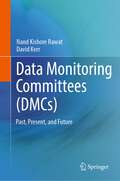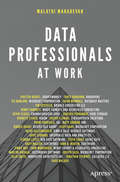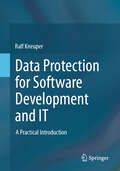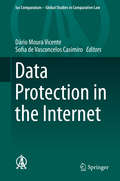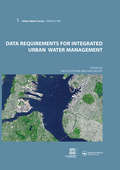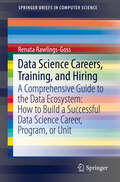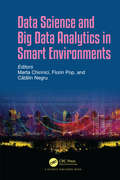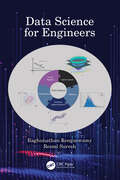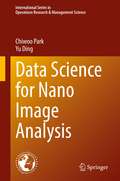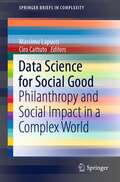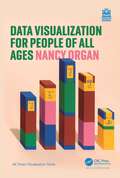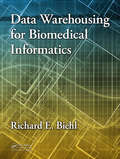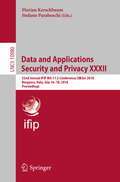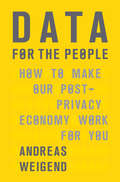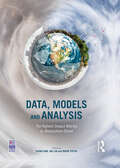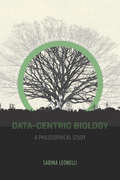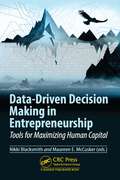- Table View
- List View
Data Monitoring Committees (DMCs): Past, Present, and Future
by David Kerr Nand Kishore RawatThis book provides an overview of Data Monitoring Committees(DMC) - what was done in the past, what is currently being done, and thoughts on improvements for the future. Previous works focused primarily on large cardiovascular studies (where DMCs originated more than 30 years ago) but updated references are needed that discuss smaller, more flexible studies in areas such as oncology. The authors have attended ~800 DMC meetings from ~200 distinct studies across all areas of clinical studies (oncology, rheumatology, rare diseases, cardiology, immunology, etc.) This wide range of expertise will be used, as well as the expertise that comes from working with virtually every large biotechnology and pharmaceutical company and CRO for DMC work. The reader of the book will know when DMCs are needed or helpful, how to form the DMC, how to work with external CROs and with sponsor teams and the DMC to create needed DMC outputs, how the DMC meetings are conducted, and - especially for DMC members - what are considerations within the Closed Session to review safety/efficacy outputs to assess risk/benefit to make appropriate recommendations that protect the patient safety and trial integrity. This is a practical hands-on book on how to decide if a DMC is necessary, how to form the DMC, how to expertly create the necessary materials for the DMC and have smooth running DMC meetings. There is no specialized training in school about how DMCs work - frequently people may have been in industry for many years without ever needing to work with a DMC. This book is the helpful reference for those new to these DMCs. The DMC work is critical to be correctly implemented as the impact of DMC activity on safeguarding the trial is so important.This book provides the following: Provides thorough instructions on the steps needed to form and implement a Data Monitoring Committee for clinical trial evaluation;Includes practical and hands-on information on DMC implementation;Discusses a wide range of clinical trial – by phase and therapeutic area.
Data Production and Analysis in Population Genomics: Methods and Protocols (Methods in Molecular Biology #888)
by Aurélie Bonin François PompanonPopulation genomics is a recently emerged discipline, which aims at understanding how evolutionary processes influence genetic variation across genomes. Today, in the era of cheaper next-generation sequencing, it is no longer as daunting to obtain whole genome data for any species of interest and population genomics is now conceivable in a wide range of fields, from medicine and pharmacology to ecology and evolutionary biology. However, because of the lack of reference genome and of enough a priori data on the polymorphism, population genomics analyses of populations will still involve higher constraints for researchers working on non-model organisms, as regards the choice of the genotyping/sequencing technique or that of the analysis methods. Therefore, Data Production and Analysis in Population Genomics purposely puts emphasis on protocols and methods that are applicable to species where genomic resources are still scarce. It is divided into three convenient sections, each one tackling one of the main challenges facing scientists setting up a population genomics study. The first section helps devising a sampling and/or experimental design suitable to address the biological question of interest. The second section addresses how to implement the best genotyping or sequencing method to obtain the required data given the time and cost constraints as well as the other genetic resources already available, Finally, the last section is about making the most of the (generally huge) dataset produced by using appropriate analysis methods in order to reach a biologically relevant conclusion. Written in the successful Methods in Molecular BiologyTM series format, chapters include introductions to their respective topics, lists of the necessary materials and reagents, step-by-step, readily reproducible protocols, advice on methodology and implementation, and notes on troubleshooting and avoiding known pitfalls. Authoritative and easily accessible, Data Production and Analysis in Population Genomics serves a wide readership by providing guidelines to help choose and implement the best experimental or analytical strategy for a given purpose.
Data Professionals at Work
by Malathi MahadevanEnjoy reading interviews with more than two dozen data professionals to see a picture of what it’s like to work in the industry managing and analyzing data, helping you to know what it takes to move from your current expertise into one of the fastest growing areas of technology today. Data is the hottest word of the century, and data professionals are in high demand. You may already be a data professional such as a database administrator or business intelligence analyst. Or you may be one of the many people who want to work as a data professional, and are curious how to get there. Either way, this collection helps you understand how data professionals work, what makes them successful, and what they do to keep up.You’ll find interviews in this book with database administrators, database programmers, data architects, business intelligence professionals, and analytics professionals. Interviewees work across industry sectors ranging from healthcare and banking to finance and transportation and beyond. Each chapter illuminates a successful professional at the top of their game, who shares what helped them get to the top, and what skills and attitudes combine to make them successful in their respective fields.Interviewees in the book include: Mindy Curnutt, Julie Smith, Kenneth Fisher, Andy Leonard, Jes Borland, Kevin Feasel, Ginger Grant, Vicky Harp, Kendra Little, Jason Brimhall, Tim Costello, Andy Mallon, Steph Locke, Jonathan Stewart, Joseph Sack, John Q. Martin, John Morehouse, Kathi Kellenberger, Argenis Fernandez, Kirsten Benzel, Tracy Boggiano, Dave Walden, Matt Gordon, Jimmy May, Drew Furgiuele, Marlon Ribunal, and Joseph Fleming. All of them have been successful in their careers, and share their perspectives on working and succeeding in the field as data and database professionals. What You'll LearnStand out as an outstanding professional in your area of data work by developing the right set of skills and attitudes that lead to successAvoid common mistakes and pitfalls, and recover from operational failures and bad technology decisionsUnderstand current trends and best practices, and stay out in front as the field evolvesBreak into working with data through database administration, business intelligence, or any of the other career paths represented in this bookManage stress and develop a healthy work-life balance no matter which career path you decide uponChoose a suitable path for yourself from among the different career paths in working with dataWho This Book Is ForDatabase administrators and developers, database and business intelligence architects, consultants, and analytic professionals, as well as those intent on moving into one of those career paths. Aspiring data professionals and those in related technical fields who want to make a move toward managing or analyzing data on a full-time basis will find the book useful. Existing data professionals who want to be outstanding and successful at what they do will also appreciate the book's advice and guidance.
Data Protection for Software Development and IT: A Practical Introduction
by Ralf KneuperThis book introduces data protection, i.e. the protection of individuals from misuse of their personal data. It provides a special focus on the direct impact on software development, e.g. in the form of functional requirements for software systems resulting from data protection. Chapter 1 provides an initial overview of the basic concepts of data protection and its legal foundations. Chapter 2 then delves deeper into the European General Data Protection Regulation (GDPR), covering in particular its basic concepts, terminology and requirements. Next, the specific implementation and interpretation of GDPR requirements in software and IT are dealt with, starting in chapter 3 with the principles of data protection defined in GDPR and the rights of data subjects in chapter 4. Chapter 5 discusses data transfer between organizations, including the relevant constellations (e.g. through various service providers), the legal framework and its practical implementation. Subsequently, chapter 6 changes the view from individual regulations and their implementation to technical and organizational design of data protection, including its embedding in the software life cycle, while chapter 7 provides an overview of information security and its aspects relevant to data protection. Eventually, chapter 8 deals with data protection for organizations as they are data subjects themselves. The appendices contain the most important excerpts from the Charter of Fundamental Rights of the EU and GDPR in this context, a collection of links to relevant laws and supervisory authorities, as well as a glossary of the most important terms used. The book’s target groups include software developers, IT consultants, requirements analysts, IT operations personnel and project managers in IT projects, but also data protection managers and data protection officers in the context of software development and IT.
Data Protection in the Internet (Ius Comparatum - Global Studies in Comparative Law #38)
by Dário Moura Vicente Sofia de Vasconcelos CasimiroThis book identifies and explains the different national approaches to data protection – the legal regulation of the collection, storage, transmission and use of information concerning identified or identifiable individuals – and determines the extent to which they could be harmonised in the foreseeable future. In recent years, data protection has become a major concern in many countries, as well as at supranational and international levels. In fact, the emergence of computing technologies that allow lower-cost processing of increasing amounts of information, associated with the advent and exponential use of the Internet and other communication networks and the widespread liberalization of the trans-border flow of information have enabled the large-scale collection and processing of personal data, not only for scientific or commercial uses, but also for political uses. A growing number of governmental and private organizations now possess and use data processing in order to determine, predict and influence individual behavior in all fields of human activity. This inevitably entails new risks, from the perspective of individual privacy, but also other fundamental rights, such as the right not to be discriminated against, fair competition between commercial enterprises and the proper functioning of democratic institutions. These phenomena have not been ignored from a legal point of view: at the national, supranational and international levels, an increasing number of regulatory instruments – including the European Union’s General Data Protection Regulation applicable as of 25 May 2018 – have been adopted with the purpose of preventing personal data misuse. Nevertheless, distinct national approaches still prevail in this domain, notably those that separate the comprehensive and detailed protective rules adopted in Europe since the 1995 Directive on the processing of personal data from the more fragmented and liberal attitude of American courts and legislators in this respect. In a globalized world, in which personal data can instantly circulate and be used simultaneously in communications networks that are ubiquitous by nature, these different national and regional approaches are a major source of legal conflict.
Data Requirements for Integrated Urban Water Management: Urban Water Series - UNESCO-IHP (Urban Water Series)
by Tim D. Fletcher and Ana DeletiicIntegrated urban water management relies on data allowing us to analyse, understand and predict the behaviour of the individual water cycle components and their interactions. The concomitant monitoring of the complex of urban water system elements makes it possible to grasp the entirety of relations among the various components of the urban water c
Data Science Careers, Training, and Hiring: A Comprehensive Guide to the Data Ecosystem: How to Build a Successful Data Science Career, Program, or Unit (SpringerBriefs in Computer Science)
by Renata Rawlings-GossThis book is an information packed overview of how to structure a data science career, a data science degree program, and how to hire a data science team, including resources and insights from the authors experience with national and international large-scale data projects as well as industry, academic and government partnerships, education, and workforce. Outlined here are tips and insights into navigating the data ecosystem as it currently stands, including career skills, current training programs, as well as practical hiring help and resources. Also, threaded through the book is the outline of a data ecosystem, as it could ultimately emerge, and how career seekers, training programs, and hiring managers can steer their careers, degree programs, and organizations to align with the broader future of data science. Instead of riding the current wave, the author ultimately seeks to help professionals, programs, and organizations alike prepare a sustainable plan for growth in this ever-changing world of data. The book is divided into three sections, the first “Building Data Careers”, is from the perspective of a potential career seeker interested in a career in data, the second “Building Data Programs” is from the perspective of a newly forming data science degree or training program, and the third “Building Data Talent and Workforce” is from the perspective of a Data and Analytics Hiring Manager. Each is a detailed introduction to the topic with practical steps and professional recommendations. The reason for presenting the book from different points of view is that, in the fast-paced data landscape, it is helpful to each group to more thoroughly understand the desires and challenges of the other. It will, for example, help the career seekers to understand best practices for hiring managers to better position themselves for jobs. It will be invaluable for data training programs to gain the perspective of career seekers, who they want to help and attract as students. Also, hiring managers will not only need data talent to hire, but workforce pipelines that can only come from partnerships with universities, data training programs, and educational experts. The interplay gives a broader perspective from which to build.
Data Science and Big Data Analytics in Smart Environments
by Marta Chinnici; Florin Pop; Cătălin NegruMost applications generate large datasets, like social networking and social influence programs, smart cities applications, smart house environments, Cloud applications, public web sites, scientific experiments and simulations, data warehouse, monitoring platforms, and e-government services. Data grows rapidly, since applications produce continuously increasing volumes of both unstructured and structured data. Large-scale interconnected systems aim to aggregate and efficiently exploit the power of widely distributed resources. In this context, major solutions for scalability, mobility, reliability, fault tolerance and security are required to achieve high performance and to create a smart environment. The impact on data processing, transfer and storage is the need to re-evaluate the approaches and solutions to better answer the user needs. A variety of solutions for specific applications and platforms exist so a thorough and systematic analysis of existing solutions for data science, data analytics, methods and algorithms used in Big Data processing and storage environments is significant in designing and implementing a smart environment.Fundamental issues pertaining to smart environments (smart cities, ambient assisted leaving, smart houses, green houses, cyber physical systems, etc.) are reviewed. Most of the current efforts still do not adequately address the heterogeneity of different distributed systems, the interoperability between them, and the systems resilience. This book will primarily encompass practical approaches that promote research in all aspects of data processing, data analytics, data processing in different type of systems: Cluster Computing, Grid Computing, Peer-to-Peer, Cloud/Edge/Fog Computing, all involving elements of heterogeneity, having a large variety of tools and software to manage them. The main role of resource management techniques in this domain is to create the suitable frameworks for development of applications and deployment in smart environments, with respect to high performance. The book focuses on topics covering algorithms, architectures, management models, high performance computing techniques and large-scale distributed systems.
Data Science and Human-Environment Systems
by Steven M. MansonTransformation of the Earth's social and ecological systems is occurring at a rate and magnitude unparalleled in human experience. Data science is a revolutionary new way to understand human-environment relationships at the heart of pressing challenges like climate change and sustainable development. However, data science faces serious shortcomings when it comes to human-environment research. There are challenges with social and environmental data, the methods that manipulate and analyze the information, and the theory underlying the data science itself; as well as significant legal, ethical and policy concerns. This timely book offers a comprehensive, balanced, and accessible account of the promise and problems of this work in terms of data, methods, theory, and policy. It demonstrates the need for data scientists to work with human-environment scholars to tackle pressing real-world problems, making it ideal for researchers and graduate students in Earth and environmental science, data science and the environmental social sciences.
Data Science and SDGs: Challenges, Opportunities and Realities
by Bikas Kumar Sinha Md. Nurul Haque MollahThe book presents contributions on statistical models and methods applied, for both data science and SDGs, in one place. Measuring and controlling data of SDGs, data driven measurement of progress needs to be distributed to stakeholders. In this situation, the techniques used in data science, specially, in the big data analytics, play an important role rather than the traditional data gathering and manipulation techniques. This book fills this space through its twenty contributions. The contributions have been selected from those presented during the 7th International Conference on Data Science and Sustainable Development Goals organized by the Department of Statistics, University of Rajshahi, Bangladesh; and cover topics mainly on SDGs, bioinformatics, public health, medical informatics, environmental statistics, data science and machine learning. The contents of the volume would be useful to policymakers, researchers, government entities, civil society, and nonprofit organizations for monitoring and accelerating the progress of SDGs.
Data Science for Engineers
by Raghunathan Rengaswamy Resmi SureshWith tremendous improvement in computational power and availability of rich data, almost all engineering disciplines use data science at some level. This textbook presents material on data science comprehensively, and in a structured manner. It provides conceptual understanding of the fields of data science, machine learning, and artificial intelligence, with enough level of mathematical details necessary for the readers. This will help readers understand major thematic ideas in data science, machine learning and artificial intelligence, and implement first-level data science solutions to practical engineering problems. <p><p> The book- <p><p> Provides a systematic approach for understanding data science techniques. Explain why machine learning techniques are able to cross-cut several disciplines. Covers topics including statistics, linear algebra and optimization from a data science perspective. Provides multiple examples to explain the underlying ideas in machine learning algorithms. Describes several contemporary machine learning algorithms. <p><p> The textbook is primarily written for undergraduate and senior undergraduate students in different engineering disciplines including chemical engineering, mechanical engineering, electrical engineering, electronics and communications engineering for courses on data science, machine learning and artificial intelligence.
Data Science for Nano Image Analysis (International Series in Operations Research & Management Science #308)
by Yu Ding Chiwoo ParkThis book combines two distinctive topics: data science/image analysis and materials science. The purpose of this book is to show what type of nano material problems can be better solved by which set of data science methods. The majority of material science research is thus far carried out by domain-specific experts in material engineering, chemistry/chemical engineering, and mechanical & aerospace engineering. The book could benefit materials scientists and manufacturing engineers who were not exposed to systematic data science training while in schools, or data scientists in computer science or statistics disciplines who want to work on material image problems or contribute to materials discovery and optimization.This book provides in-depth discussions of how data science and operations research methods can help and improve nano image analysis, automating the otherwise manual and time-consuming operations for material engineering and enhancing decision making for nano material exploration. A broad set of data science methods are covered, including the representations of images, shape analysis, image pattern analysis, and analysis of streaming images, change points detection, graphical methods, and real-time dynamic modeling and object tracking. The data science methods are described in the context of nano image applications, with specific material science case studies.
Data Science for Social Good: Philanthropy and Social Impact in a Complex World (SpringerBriefs in Complexity)
by Massimo Lapucci Ciro CattutoThis book is a collection of reflections by thought leaders at first-mover organizations in the exploding field of "Data Science for Social Good", meant as the application of knowledge from computer science, complex systems and computational social science to challenges such as humanitarian response, public health, sustainable development. The book provides both an overview of scientific approaches to social impact – identifying a social need, targeting an intervention, measuring impact – and the complementary perspective of funders and philanthropies that are pushing forward this new sector. This book will appeal to students and researchers in the rapidly growing field of data science for social impact, to data scientists at companies whose data could be used to generate more public value, and to decision makers at nonprofits, foundations, and agencies that are designing their own agenda around data.
Data Science in Air Quality Monitoring (Engineering Applications of Computational Methods #23)
by Hui Liu Yanfei Li Zhu DuanThis book presents a series of state-of-the-art methods for air quality monitoring in various engineering environment by using data science. In the book, the data-driven key techniques of the preprocessing, decomposition, identification, clustering, forecasting and interpolation of the air quality monitoring are explained in details with lots of experimental simulation. The book can provide important reference for the development of data science technologies in engineering air quality monitoring. The book can be used for students, engineers, scientists and managers in the fields of environmental engineering, atmospheric science, urban climate, civil engineering, traffic and vehicle engineering, etc.
Data Science in Engineering Vol. 10: Proceedings of the 42nd IMAC, A Conference and Exposition on Structural Dynamics 2024 (Conference Proceedings of the Society for Experimental Mechanics Series)
by François Hemez Austin Downey Thomas Matarazzo Eleonora Maria TronciData Science in Engineering, Volume 10: Proceedings of the 42nd IMAC, A Conference and Exposition on Structural Dynamics, 2024, the tenth volume of ten from the Conference brings together contributions to this important area of research and engineering. The collection presents early findings and case studies on fundamental and applied aspects of Data Science in Engineering, including papers on: Novel Data-driven Analysis Methods Deep Learning Gaussian Process Analysis Real-time Video-based Analysis Applications to Nonlinear Dynamics and Damage Detection Data-driven System Prognostics
Data Science with R for Psychologists and Healthcare Professionals
by Christian RyanThis introduction to R for students of psychology and health sciences aims to fast-track the reader through some of the most difficult aspects of learning to do data analysis and statistics. It demonstrates the benefits for reproducibility and reliability of using a programming language over commercial software packages such as SPSS. The early chapters build at a gentle pace, to give the reader confidence in moving from a point-and-click software environment, to the more robust and reliable world of statistical coding. This is a thoroughly modern and up-to-date approach using RStudio and the tidyverse. A range of R packages relevant to psychological research are discussed in detail. A great deal of research in the health sciences concerns questionnaire data, which may require recoding, aggregation and transformation before quantitative techniques and statistical analysis can be applied. R offers many useful and transparent functions to process data and check psychometric properties. These are illustrated in detail, along with a wide range of tools R affords for data visualisation. Many introductory statistics books for the health sciences rely on toy examples - in contrast, this book benefits from utilising open datasets from published psychological studies, to both motivate and demonstrate the transition from data manipulation and analysis to published report. R Markdown is becoming the preferred method for communicating in the open science community. This book also covers the detail of how to integrate the use of R Markdown documents into the research workflow and how to use these in preparing manuscripts for publication, adhering to the latest APA style guidelines.
Data Stewardship for Open Science: Implementing FAIR Principles
by Barend MonsData Stewardship for Open Science: Implementing FAIR Principles has been written with the intention of making scientists, funders, and innovators in all disciplines and stages of their professional activities broadly aware of the need, complexity, and challenges associated with open science, modern science communication, and data stewardship. The FAIR principles are used as a guide throughout the text, and this book should leave experimentalists consciously incompetent about data stewardship and motivated to respect data stewards as representatives of a new profession, while possibly motivating others to consider a career in the field. The ebook, avalable for no additional cost when you buy the paperback, will be updated every 6 months on average (providing that significant updates are needed or avaialble). Readers will have the opportunity to contribute material towards these updates, and to develop their own data management plans, via the free Data Stewardship Wizard.
Data Visualization for People of All Ages (ISSN)
by Nancy OrganData visualization is the art and science of making information visible. On paper and in our imaginations, it’s a language of shapes and colors that holds our best ideas and most important questions. As we find ourselves swimming in data of all kinds, visualization can help us to understand, express, and explore the richness of the world around us. No matter your age or background, this book opens the door to new ways of thinking and sharing through the power of data visualization.Data Visualization for People of All Ages is a field guide to visual literacy, born from the author’s personal experience working with world-class scholars, engineers, and scientists. By walking through the different ways of showing data—including color, angle, position, and length—you’ll learn how charts and graphs truly work so that no visualization is ever a mystery or out of reach. It doesn’t stop at what fits on a page, either. You’ll journey into cutting-edge topics like data sonification and data physicalization, using sound and touch to share data across the different senses. Packed with practical examples and exercises to help you connect the dots, this book will teach you how to create and understand data visualizations on your own—all without writing a single line of code or getting tangled up in software.Written with accessibility in mind, this book invites everyone to the table to share the joy of one of today’s most necessary skills. Perfect for home or classroom use, this friendly companion gives people of all ages everything they need to start visualizing with confidence.
Data Warehousing for Biomedical Informatics
by Richard E. BiehlData Warehousing for Biomedical Informatics is a step-by-step how-to guide for designing and building an enterprise-wide data warehouse across a biomedical or healthcare institution, using a four-iteration lifecycle and standardized design pattern. It enables you to quickly implement a fully-scalable generic data architecture that supports your organization's clinical, operational, administrative, financial, and research data. By following the guidelines in this book, you will be able to successfully progress through the Alpha, Beta, and Gamma versions, plus fully implement your first production release in about a year.
Data and Applications Security and Privacy XXXII: 32nd Annual IFIP WG 11.3 Conference, DBSec 2018, Bergamo, Italy, July 16–18, 2018, Proceedings (Lecture Notes in Computer Science #10980)
by Florian Kerschbaum Stefano ParaboschiThis book constitutes the refereed proceedings of the 32nd Annual IFIP WG 11.3 International Working Conference on Data and Applications Security and Privacy, DBSec 2018, held in Bergamo, Italy, in July 2018. The 16 full papers and 5 short papers presented were carefully reviewed and selected from 50 submissions. The papers present high-quality original research from academia, industry, and government on theoretical and practical aspects of information security. They are organized in topical sections on administration, access control policies, privacy-preserving access and computation, integrity and user interaction, security analysis and private evaluation, fixing vulnerabilities, and networked systems.
Data for the People: How to Make Our Post-Privacy Economy Work for You
by Andreas WeigendA long-time chief data scientist at Amazon shows how open data can make everyone, not just corporations, richerEvery time we Google something, Facebook someone, Uber somewhere, or even just turn on a light, we create data that businesses collect and use to make decisions about us. In many ways this has improved our lives, yet, we as individuals do not benefit from this wealth of data as much as we could. Moreover, whether it is a bank evaluating our credit worthiness, an insurance company determining our risk level, or a potential employer deciding whether we get a job, it is likely that this data will be used against us rather than for us.In Data for the People, Andreas Weigend draws on his years as a consultant for commerce, education, healthcare, travel and finance companies to outline how Big Data can work better for all of us. As of today, how much we benefit from Big Data depends on how closely the interests of big companies align with our own. Too often, outdated standards of control and privacy force us into unfair contracts with data companies, but it doesn't have to be this way. Weigend makes a powerful argument that we need to take control of how our data is used to actually make it work for us. Only then can we the people get back more from Big Data than we give it.Big Data is here to stay. Now is the time to find out how we can be empowered by it.
Data, Models and Analysis: The Highest Impact Articles in 'Atmosphere-Ocean'
by Guoqi Han, Hai Lin and Douw SteynThis volume contains the ten most cited articles that have appeared in the journal Atmosphere-Ocean since 1995. These articles cover a wide range of topics in meteorology, climatology and oceanography. Modelling work is represented in five papers, covering global climate model development; a cumulus parameterization scheme for global climate models; development of a regional forecast modelling system and parameterization of peatland hydraulic processes for climate models. Data rehabilitation and compilation in order to support trend analysis work on comprehensive precipitation and temperature data sets is presented in four papers. Field studies are represented by a paper on the circumpolar lead system. While the modelling studies are global in their application and applicability, the data analysis and field study papers cover environments that are specifically, but not uniquely, Canadian. This book will be of interest to researchers, students and professionals in the various sub-fields of meteorology, oceanography and climate science.
Data-Centric Biology: A Philosophical Study
by Sabina LeonelliIn recent decades, there has been a major shift in the way researchers process and understand scientific data. Digital access to data has revolutionized ways of doing science in the biological and biomedical fields, leading to a data-intensive approach to research that uses innovative methods to produce, store, distribute, and interpret huge amounts of data. In Data-Centric Biology, Sabina Leonelli probes the implications of these advancements and confronts the questions they pose. Are we witnessing the rise of an entirely new scientific epistemology? If so, how does that alter the way we study and understand life—including ourselves? Leonelli is the first scholar to use a study of contemporary data-intensive science to provide a philosophical analysis of the epistemology of data. In analyzing the rise, internal dynamics, and potential impact of data-centric biology, she draws on scholarship across diverse fields of science and the humanities—as well as her own original empirical material—to pinpoint the conditions under which digitally available data can further our understanding of life. Bridging the divide between historians, sociologists, and philosophers of science, Data-Centric Biology offers a nuanced account of an issue that is of fundamental importance to our understanding of contemporary scientific practices.
Data-Driven Analytics for the Geological Storage of CO2
by Shahab MohagheghData-driven analytics is enjoying unprecedented popularity among oil and gas professionals. Many reservoir engineering problems associated with geological storage of CO2 require the development of numerical reservoir simulation models. This book is the first to examine the contribution of artificial intelligence and machine learning in data-driven analytics of fluid flow in porous environments, including saline aquifers and depleted gas and oil reservoirs. Drawing from actual case studies, this book demonstrates how smart proxy models can be developed for complex numerical reservoir simulation models. Smart proxy incorporates pattern recognition capabilities of artificial intelligence and machine learning to build smart models that learn the intricacies of physical, mechanical and chemical interactions using precise numerical simulations. This ground breaking technology makes it possible and practical to use high fidelity, complex numerical reservoir simulation models in the design, analysis and optimization of carbon storage in geological formations projects.
Data-Driven Decision Making in Entrepreneurship: Tools for Maximizing Human Capital
by Nikki Blacksmith Maureen E. McCuskerSince the beginning of the 21st century, there has been an explosion in startup organizations. Together, these organizations have been valued at over $3 trillion. In 2019, alone, nearly $300 billion of venture capital was invested globally (Global Startup Ecosystem Report 2020). Simultaneously, an explosion in high volume and high velocity of big data is rapidly changing how organizations function. Gone are the days where organizations can make decisions solely on intuition, logic, or experience. Some have gone as far as to say that data is the most valuable currency and resource available to businesses, and startups are no exception. However, startups and small businesses do differ from their larger counterparts and corporations in three distinct ways: 1) they tend to have fewer resources, time, and specialized training to devote to data analytics; 2) they are part of a unique entrepreneurial ecosystem with unique needs; 3) scholarship and academic research on human capital data analytics in startups is lacking. Existing entrepreneurship research focuses almost exclusively on macro-level aspects. There has been little to no integration of micro- and meso-level research (i.e., individual and team sciences), which is unfortunate given how organizational scientists have significantly advanced human capital data analytics. Unlike other books focused on data analytics and decision for organizations, this proposed book is purposefully designed to be more specifically aimed at addressing the unique idiosyncrasies of the science, research, and practice of startups. Each chapter highlights a specific organizational domain and discuss how a novel data analytic technique can help enhance decision-making, provides a tutorial of said regarding the data analytic technique, and lists references and resources for the respective data analytic technique. The volume will be grounded in sound theory and practice of organizational psychology, entrepreneurship and management and is divided into two parts: assessing and evaluating human capital performance and the use of data analytics to manage human capital.
